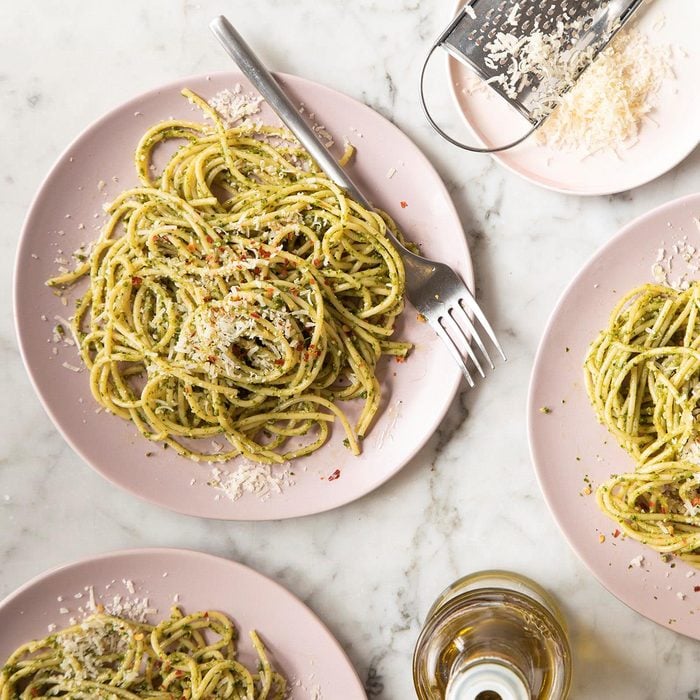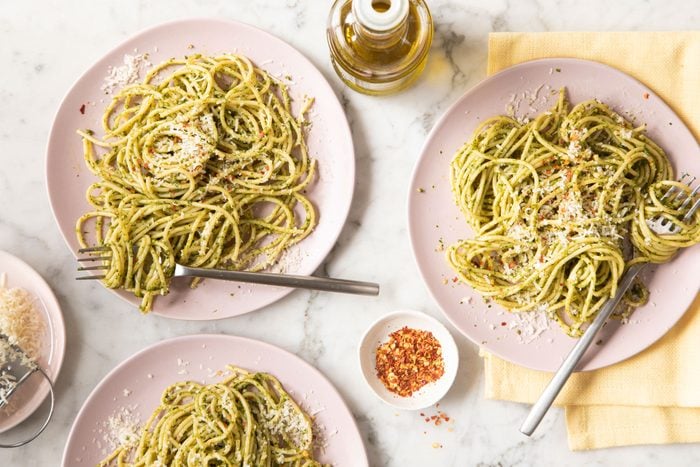Did you know that opened pesto technically lasts for just 5 days in the refrigerator? Admittedly, we’ve used the fragrant, flavorful and sometimes expensive green sauce much past its prime simply because we hate to see any go to waste.
However, if you have leftover pesto—whether it’s an entire container or a few servings worth—there are lots of delicious and easy ways to use it up. We have tons of recipes with pesto! When you’re looking for last-minute dinner ideas, pesto pasta is one that’s easily elegant and always satisfying.
Pesto Pasta Ingredients
- Pesto: Our recipe calls for classic homemade pesto, made with basil, pine nuts, Parmesan and olive oil. However, you can use your favorite variation of pesto, whether it’s arugula pesto, spinach pesto or even sweet pea pesto. You can also use a good store-bought pesto if you want to save time.
- Noodles: While we use spaghetti, you can really use any kind of pasta shape you like. Long, thin noodles like fettuccine, bucatini and pappardelle are often best for pesto, although you can also go for short, textured noodles if that’s what you have on hand.
- Parmesan: Make sure to grate the cheese yourself. It will melt better than the pre-shredded kind.
Directions
Step 1: Cook the pasta
Cook the spaghetti according to package directions. Drain, reserving 1 cup of pasta water.
Editor’s Tip: Don’t forget the salt! Know how to salt pasta water the right way so your noodles are flavored just enough.
Step 2: Make the pesto pasta sauce
In a large bowl, whisk the pesto and 1/3 cup pasta water. Add the cooked spaghetti, and toss to coat.
Editor’s Tip: Adding the starchy pasta water to the pesto loosens up the sauce a bit, and makes it go further in your dish.
Step 3: Adjust the sauce, if necessary
Add more pasta water to reach your desired consistency. If you want a more concentrated sauce for the noodles, go with less water.
Step 4: Sprinkle with cheese and serve
Sprinkle with Parmesan, and, if desired, red pepper flakes for a little kick.
How should you store leftover pesto pasta?
Keep any remaining pasta in an airtight container in the fridge. When you’re hungry again, be very careful about reheating the leftovers, because pesto can easily turn black with high heat. If you like, you can also eat this pesto pasta cold, like you would a pasta salad.
Pesto Pasta Tips
What’s the best pasta shape for pesto?
Pesto is a pretty versatile sauce. It’s typically paired with long noodles like spaghetti, linguine, bucatini, cappellini and fettuccine, but short, textured noodles such as orecchiete and gemelli will work too.
What else can you add to pesto pasta?
If you want to elevate pesto pasta, there are many ingredients that will serve your purpose. If you’d prefer a softer, more decadent cheese than Parm, go for little mozzarella pearls or roughly chopped burrata. Add some veggies with blistered cherry tomatoes, thinly sliced roasted red peppers or roasted cauliflower. Fresh basil, a sprinkle of pine nuts and a touch of freshly cracked pepper would also add so much flavor. If you want to add protein, try grilled chicken or crispy prosciutto.
What can you serve with pesto pasta?
Your favorite garlic bread recipe would complement pesto pasta nicely, as would a simple side salad.


